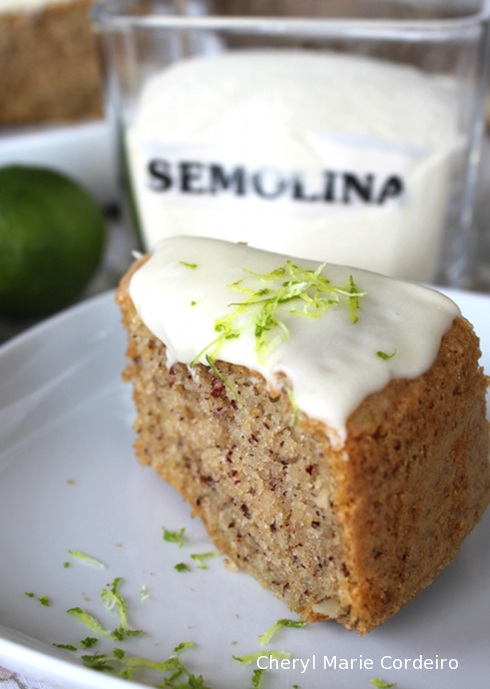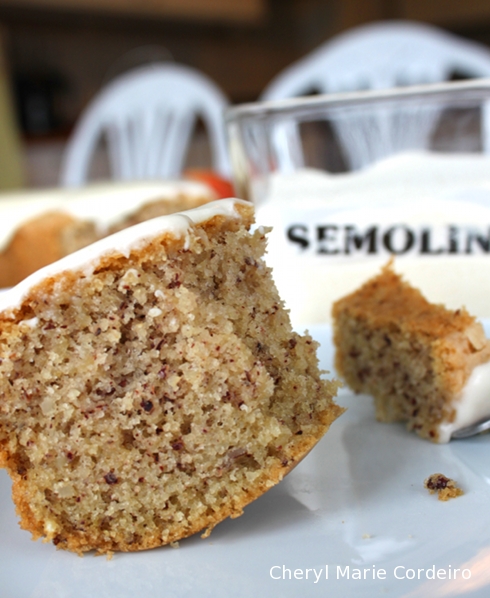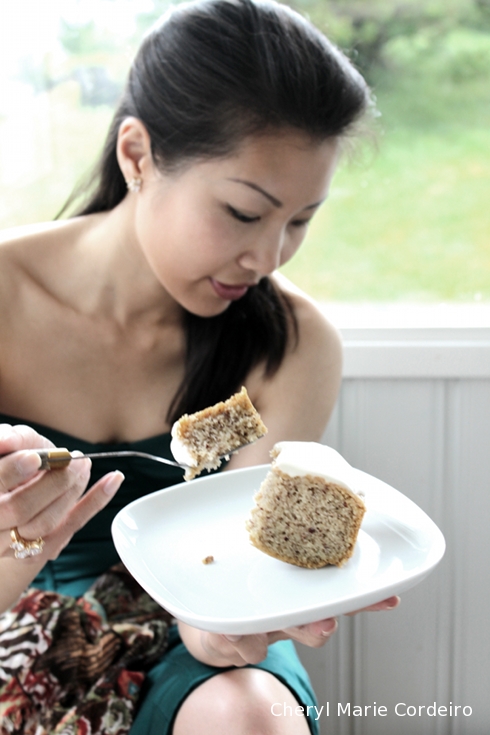For anyone with an adventurous mindset, I would like to share my take on a rustic version of the Eurasian Almond Sugee Cake, made with unblanched almonds, topped with almond-vanilla icing.

My vesion of the Eurasian almond pastel de sémola de rústica, served with the grated zest of a lime atop the almond-vanilla icing glaze.
Text and Photo © JE Nilsson and CM Cordeiro 2012
As a little Eurasian girl growing up in Singapore, I can remember Almond Sugee / Semolina Cake from a very early age. In my family it was also my father who carried the Eurasian heritage forward and who had baked the cake in the family well before I was born.

My grandmother, Dorothy Yap, and me in 1978.
To all appearances this cake might well have a long history stemming from Medieval Europe where we can find numerous variations of similar semolina cakes today. Some googling around, shows that in the Middle Eastern countries, they have variations of Revani (an orange semolina cake), Namoura (without eggs) and Basboosa (with coconut and yoghurt). In south Europe, Italy has its own variations of torta di semolino made with lemon or orange, and from India to Southeast-Asia, there are variations of the sugee / sooji cake made with essence of rose or rose syrup poured over the cake after baking and cooling.
The recipes also vary with regards to the use of semolina, with some recipes using pure semolina flour and others calling for a mix of semolina and plain flour.

There are different types of semolina made from rice (white semolina) and buckwheat but the Eurasian sugee cake calls for the semolina from durum wheat also known as mannagryn in Sweden. Mannagryn kaka is found in Sweden, some cakes being made with coconut, while others made with lemon.
Apart from that this cake is obviously very rich – with many eggs and a lot of butter – it is moreover, made with a wheat flour that is specifically recognized as being coarsely ground. It is thus not that far fetched to ponder if this cake maybe stemmed from a time when preparing food was also an important way of preserving it and making it transportable, and when flour was coarsely ground just because it was difficult to make it as fine as we usually take for granted it should be, today. In that sense, a mixture of semolina and fine flour would probably be what is most historically correct.
In that mindset it occurred to me that while I completely enjoy its decadent, rich with egg yolks flavour so imprinted on my palate, I found it interesting to venture back in our seafaring history, and experiment with a rustic version of the Eurasian Almond Sugee Cake made with coarse ground unblanched almonds.
Not surprisingly it turns out that some zest from the seafarer’s traditional Vitamin C source above all, a citrus fruit, adds a crown of flavour turning this cake into a retrospective adventure on its own. And one that would easily stand up to an addditional cup of rum poured over it ahead of serving.

A visual delight – richly speckled – with unblanched almonds.
The recipe and method that I use for this version of the cake is the one presented in my previous blog Sémola panque de almendras – the Eurasian Almond Sugee Cake, with the exception that the almonds are ground unblanched.
Ingredients
500g fine semolina / sugee flour
500g butter
500g castor sugar (250g in two separate bowls)
500g almonds (unblanched, coarsely ground)
1 vanilla pod (contents scraped added to the semolina)
1/2 tsp bitter almond extract
1 tsp baking powder
1 tsp baking soda
1 tsp cream of tartar
10 egg yolks
11 egg whites
2 tbsp brandy
pinch of salt
Baked at 175C oven
This cake always begins with soaking the semolina in the melted butter for at least four hours, preferably over night to plump up the grains.

The result of unblanched almonds is a gorgeously brown speckled cake with a rich almond flavour coming from the skins of the nut that looks enticing when served.
Not one for pure hard candy or icing on cakes in general, I find that this cake in particular takes well to a thin layer of almond-vanilla icing due to the mild bitter-almond taste that allows for a sweet coating atop.
A complete indulgence that could possibly tempt the attention of Dionysus, this is a rich and substantial cake that is served best in small portions with a cup of short strong coffee.